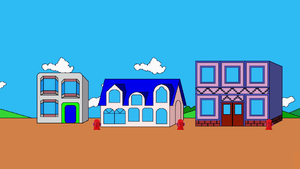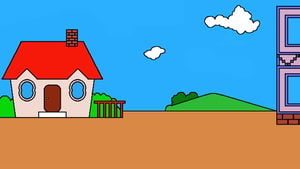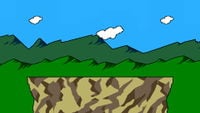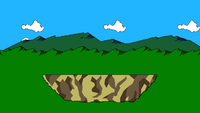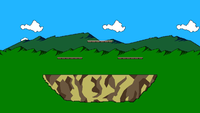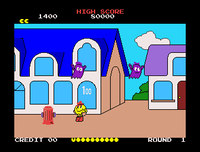Pac-Land: Difference between revisions
BubzieBobkat (talk | contribs) mNo edit summary |
m (Text replacement - "class=("?)invert\b([^-])" to "class=$1invert-dark$2") |
||
| (15 intermediate revisions by 7 users not shown) | |||
| Line 3: | Line 3: | ||
|subtitle = ''{{s|wikipedia|Pac-Land}}'' | |subtitle = ''{{s|wikipedia|Pac-Land}}'' | ||
|name = Pac-Land | |name = Pac-Land | ||
|image = {{tabber|title1=Ultimate| | |image = {{tabber|title1=Ultimate|content1=[[File:SSBU-Pac-Land.png|300px]]|title2=Wii U|content2=[[File:SSB4UPac-Land.jpg|300px]]}} | ||
|caption = [[File:PacManSymbol.svg|50px|class=invert]]<br>Pac-Land as it appears in ''Smash''. | |caption = [[File:PacManSymbol.svg|50px|class=invert-dark]]<br>Pac-Land as it appears in ''Smash''. | ||
|universe = {{uv|Pac-Man}} | |universe = {{uv|Pac-Man}} | ||
|games = ''[[SSB4]]'' ([[SSB4-U|Wii U]])<br>''[[Ultimate]]'' | |games = ''[[SSB4]]'' ([[SSB4-U|Wii U]])<br>''[[Ultimate]]'' | ||
|availability = [[Unlockable stage|Unlockable]] (''SSB4'')<br>[[Starter stage|Starter]] (''Ultimate'') | |availability = [[Unlockable stage|Unlockable]] (''SSB4'')<br>[[Starter stage|Starter]] (''Ultimate'') | ||
|cratetype = Presents | |cratetype = Presents | ||
| Line 59: | Line 58: | ||
==Origin== | ==Origin== | ||
[[File:PacLandArcade.png|left|thumb|The town level as it originally appeared in ''Pac-Land''. A fire hydrant can also be seen.]] | [[File:PacLandArcade.png|left|thumb|The town level as it originally appeared in ''Pac-Land''. A fire hydrant can also be seen.]] | ||
The stage is a faithful recreation of the 1984 arcade game ''{{s|wikipedia|Pac-Land}}'', a side-scroller where Pac-Man sets off to return a lost fairy to her home. Starting at his house, Pac-Man goes left-to-right through three areas before reaching Fairyland. In exchange for returning the fairy, he receives a pair of Wing Shoes, which allow him to jump indefinitely. He then travels right-to-left through a fourth area to head home, after which the cycle repeats. Every area except the Castle is featured in this stage. While the original game's levels change as the game progresses, the Pac-Land stage has a predetermined layout that always remains the same | The stage is a faithful recreation of the 1984 arcade game ''{{s|wikipedia|Pac-Land}}'', a side-scroller where Pac-Man sets off to return a lost fairy to her home. Starting at his house, Pac-Man goes left-to-right through three areas before reaching Fairyland. In exchange for returning the fairy, he receives a pair of Wing Shoes, which allow him to jump indefinitely. He then travels right-to-left through a fourth area to head home, after which the cycle repeats. Every area except the Castle is featured in this stage. While the original game's levels change as the game progresses, the Pac-Land stage has a predetermined layout that always remains the same. | ||
''Pac-Land'' is notable for being one of the first games to use {{s|wikipedia|parallax scrolling}} (where the foreground and background move at different speeds to simulate perspective), long before it became a gaming mainstay in the 16-bit era. This effect is replicated in the ''Smash'' stage. | ''Pac-Land'' was loosely based on, and named after, the setting of the {{s|wikipedia|Hanna-Barbera}} [[wikipedia:Pac-Man (TV series)|''Pac-Man'' cartoon]]. It was the first Namco-developed installment in the ''Pac-Man'' series to feature the more anthropomorphic designs of the ''Pac-Man'' characters in-game. ''Pac-Land'' is notable for being one of the first games to use {{s|wikipedia|parallax scrolling}} (where the foreground and background move at different speeds to simulate perspective), long before it became a gaming mainstay in the 16-bit era. This effect is replicated in the ''Smash'' stage. Other elements of the stage are taken directly from the original game: the Helmet, Special Pac, and Wing Shoes power-ups are obtained in identical ways and result in similar effects to their original appearances. | ||
When {{s|wikipedia|Bally Midway}} localized the western release of ''Pac-Land'', they modified the sprites of Pac-Man and his family to further resemble the Hanna-Barbera model sheets, as opposed to their appearances from Japanese ''Pac-Man'' artwork used in the Japanese version; they also added cameos from Pac-Man's pets in the cartoon, Chomp Chomp and Sour Puss, and removed the Christian cross from a church in the background. The level in ''Smash'' is based largely on the Japanese version, with a fairy appearing in the level introduction instead of Pac-Man's pets, as well as Ms. Pac-Man using her Japanese design; however, the church still lacks its Christian cross, as in the western release. | |||
The setting of Pac-Land reappears in later ''Pac-Man'' games, but with different designs. Its most notable appearances afterwards are in ''{{s|wikipedia|Pac-Man World 2}}'' and ''{{s|wikipedia|Pac-Man 2: The New Adventures}}''. | |||
Ms. Pac-Man was a character created not by Namco, but by the General Computer Corporation for Midway, being the namesake of her debut game. ''Pac-Land'' was the first appearance of the character in Japan. Initially a Midway property, Bandai Namco would later take ownership of the character, with a portion of royalties for her appearances and merchandise owed to GCC — however, starting in the 2010s, a lawsuit over failure on Bandai Namco's part to pay royalties would lead to Ms. Pac-Man being unnamed, replaced, or outright omitted from ''Pac-Man'' titles.<ref>[https://www.scribd.com/document/427639682/Bandai-Namco-Entertainment-of-America-vs-AtGames-2019-complaint?irclickid=26sXurxaIxyPRa3Sw9WC1TLRUkFWSczwExW7Vo0&irpid=10078&utm_source=impact&utm_medium=cpc&utm_campaign=affiliate_pdm_acquisition_Skimbit%20Ltd.&sharedid=polygon.com&irgwc=1#from_embed&referrer=polygon.com&sref=https://www.polygon.com/2019/9/26/20886032/ms-pac-man-lawsuit-bandai-namco-atgames-rights-royalties]</ref> The legal dispute came to a head in the early 2020s, with Bandai Namco creating a consistent replacement character named "Pac-Mom" after GCC's portion of the rights were bought by micro-console manufacturer AtGames. Pac-Mom would replace Ms. Pac-Man in re-releases and remakes of titles such as ''Pac-Land'', ''Pac-In-Time'', and ''Pac-Man World''. ''Super Smash Bros. Ultimate'' is, to date, the final appearance of Ms. Pac-Man in a new title. | |||
{{clrl}} | {{clrl}} | ||
| Line 119: | Line 118: | ||
*Despite the stage being based on ''Pac-Land'', no music from the game is featured in either ''for Wii U'' or ''Ultimate''. Because of this, Pac-Land is the only stage without any music being from its origin game. | *Despite the stage being based on ''Pac-Land'', no music from the game is featured in either ''for Wii U'' or ''Ultimate''. Because of this, Pac-Land is the only stage without any music being from its origin game. | ||
*On this stage, the music will not start until after the countdown has finished, in reference to similar behavior in ''Pac-Land''. | *On this stage, the music will not start until after the countdown has finished, in reference to similar behavior in ''Pac-Land''. | ||
*Pac-Baby (known as Baby Pac-Man at the time) is not featured in the stage at all, despite being present in all iterations of the original game. | |||
*The following [[Assist Trophies]] cannot appear on this stage: [[Thwomp]], [[Moon]], [[Mother Brain]], [[Nightmare]], [[Andross]], [[Jeff]], [[Black Knight]], [[Kapp'n]], [[Color TV-Game 15]], [[Devil]], [[Dr. Wright]], [[Nikki]], [[Yuri Kozukata]], [[Arcade Bunny]], [[Squid Sisters]], [[Ghosts]] and [[Shadow the Hedgehog]]. Additionally, the following [[Poké Ball]] summons cannot appear on this stage: [[Abra]], [[Alolan Exeggutor]], [[Snorlax]], [[Lugia]], [[Xerneas]], [[Lunala]] and [[Marshadow]]. | *The following [[Assist Trophies]] cannot appear on this stage: [[Thwomp]], [[Moon]], [[Mother Brain]], [[Nightmare]], [[Andross]], [[Jeff]], [[Black Knight]], [[Kapp'n]], [[Color TV-Game 15]], [[Devil]], [[Dr. Wright]], [[Nikki]], [[Yuri Kozukata]], [[Arcade Bunny]], [[Squid Sisters]], [[Ghosts]] and [[Shadow the Hedgehog]]. Additionally, the following [[Poké Ball]] summons cannot appear on this stage: [[Abra]], [[Alolan Exeggutor]], [[Snorlax]], [[Lugia]], [[Xerneas]], [[Lunala]] and [[Marshadow]]. | ||
==References== | |||
{{reflist}} | |||
{{SSB4Stages}} | {{SSB4Stages}} | ||
Latest revision as of 13:27, May 20, 2024
| Pac-Land Pac-Land | |
|---|---|
 Pac-Land as it appears in Smash. | |
| Universe | Pac-Man |
| Appears in | SSB4 (Wii U) Ultimate |
| Availability | Unlockable (SSB4) Starter (Ultimate) |
| Unlock criteria | Play all 3 maps in Smash Tour. |
| Crate type | Presents |
| Maximum players | 6 (Wii U) 8 (Wii U Ω form, Ultimate) |
| Article on Wikipedia | Pac-Land |
| “ | This is an auto-scrolling stage where the scene continuously changes. There are also a few hidden features from the original arcade version of PAC-LAND, so try to find them! | ” |
| —Super Smash Blog, Super Smash Bros. Ultimate Official Site | ||
Pac-Land (パックランド, Pac-Land), also stylized PAC-LAND, is a stage in Super Smash Bros. for Wii U and Super Smash Bros. Ultimate. In Ultimate, Pac-Man is fought here for his unlock battle.
Stage overview[edit]
Similar to Mushroomy Kingdom from Brawl and 3D Land from the 3DS version, Pac-Land is a side scrolling stage that moves automatically. The scrolling speed is dependent on each player's location: moving ahead will speed it up, while lagging behind will slow it down. The stage follows the layout of the original Pac-Land arcade game, going through three rounds before reaching Fairyland. After this, the stage scrolls back to the left, mimicking Pac-Man's return trip in the original game. After each of the first two rounds, a "Break Time" sign appears, and a point display is shown; this is purely aesthetic, and no high score is kept.
The stage starts at Pac-Man's House, and scrolls through a town where buildings can be used as platforms. Three Fire Hydrants appear in the first section, shooting water that pushes players back. The second section is a forest where players appear as silhouettes behind the trees. Three tree trunks appear as obstacles. Out of the six total hydrant and log obstacles, two are randomly selected to be pushable to the right. If done correctly, the player to do so is rewarded by temporarily growing, akin to touching a Super Mushroom. The third section is a bridge consisting of platforms suspended above water (which players cannot swim in). A model ship can be collected to add extra platforms, and water spouts serve as damaging hazards. The stage then transitions to Fairyland, where the Mother Fairy appears. She spawns a pair of Wing Shoes that reward a player with a temporary boost to jump height.
The stage then begins scrolling right-to-left, signalling the return trip. It starts with tall cacti that serve as obstacles, before moving into a canyon area that features collapsing log bridges. Hitting a certain point spawns a Special Pac item that grants temporary invincibility. After passing by a small lake, the stage returns to the town. Pushing a certain hydrant releases balloons that heal damage when touched. The stage ends at Pac-Man's house, where Ms. Pac-Man can be seen. The cycle then starts over again on a new trip.
Every time a cycle starts, a splash screen displays the number of the current trip. Each cycle takes approximately two minutes and thirty seconds to complete. Unlike the original Pac-Land, the cycles are the same each time, although the color of the sky is dependent on the trip (starting at midday and cycling through evening, night, and morning before returning to day).
Ω forms and Battlefield form[edit]
In Super Smash Bros. for Wii U, the Ω form of this stage takes place in the canyon area. Despite having walls and a platform extending below the blast line, wall jumps are impossible here; this is the only stage with this distinction.
In Super Smash Bros Ultimate, the Ω form and Battlefield form are similar to the Ω form in SSB4; however, the main platform does not extend below the blast line and is resized and reshaped to match Final Destination and Battlefield, respectively. The three soft platforms of the Battlefield form are made of pixelated wood and are unique to this form. The characters are still flat, which also flattens the hitboxes and alters gameplay significantly as a result.
Hazards Off[edit]
With hazards off in Ultimate, the stage still scrolls, and its speed is still affected by the positions of the fighters. However, several other changes are made to the stage:
- Hydrants will not spit water.
- Although there are still randomly selected hydrants and tree trunks that can be pushed, they will neither increase the size of the player, nor will they spawn balloons on the return trip.
- The model ship does not appear in the bridge section, and the platform it spawns will not appear.
- No water spouts will appear in the bridge section.
- Although the Mother Fairy still spawns the Wing Shoes, they cannot be collected.
- The Super Pac item does not appear on the return trip.
- The log bridges in the canyon do not spin or collapse.
- The cloud platforms in the canyon and above the lake do not move.
- Although the springboard still appears next to the lake, it is nonfunctional.
Origin[edit]
The stage is a faithful recreation of the 1984 arcade game Pac-Land, a side-scroller where Pac-Man sets off to return a lost fairy to her home. Starting at his house, Pac-Man goes left-to-right through three areas before reaching Fairyland. In exchange for returning the fairy, he receives a pair of Wing Shoes, which allow him to jump indefinitely. He then travels right-to-left through a fourth area to head home, after which the cycle repeats. Every area except the Castle is featured in this stage. While the original game's levels change as the game progresses, the Pac-Land stage has a predetermined layout that always remains the same.
Pac-Land was loosely based on, and named after, the setting of the Hanna-Barbera Pac-Man cartoon. It was the first Namco-developed installment in the Pac-Man series to feature the more anthropomorphic designs of the Pac-Man characters in-game. Pac-Land is notable for being one of the first games to use parallax scrolling (where the foreground and background move at different speeds to simulate perspective), long before it became a gaming mainstay in the 16-bit era. This effect is replicated in the Smash stage. Other elements of the stage are taken directly from the original game: the Helmet, Special Pac, and Wing Shoes power-ups are obtained in identical ways and result in similar effects to their original appearances.
When Bally Midway localized the western release of Pac-Land, they modified the sprites of Pac-Man and his family to further resemble the Hanna-Barbera model sheets, as opposed to their appearances from Japanese Pac-Man artwork used in the Japanese version; they also added cameos from Pac-Man's pets in the cartoon, Chomp Chomp and Sour Puss, and removed the Christian cross from a church in the background. The level in Smash is based largely on the Japanese version, with a fairy appearing in the level introduction instead of Pac-Man's pets, as well as Ms. Pac-Man using her Japanese design; however, the church still lacks its Christian cross, as in the western release.
The setting of Pac-Land reappears in later Pac-Man games, but with different designs. Its most notable appearances afterwards are in Pac-Man World 2 and Pac-Man 2: The New Adventures.
Ms. Pac-Man was a character created not by Namco, but by the General Computer Corporation for Midway, being the namesake of her debut game. Pac-Land was the first appearance of the character in Japan. Initially a Midway property, Bandai Namco would later take ownership of the character, with a portion of royalties for her appearances and merchandise owed to GCC — however, starting in the 2010s, a lawsuit over failure on Bandai Namco's part to pay royalties would lead to Ms. Pac-Man being unnamed, replaced, or outright omitted from Pac-Man titles.[1] The legal dispute came to a head in the early 2020s, with Bandai Namco creating a consistent replacement character named "Pac-Mom" after GCC's portion of the rights were bought by micro-console manufacturer AtGames. Pac-Mom would replace Ms. Pac-Man in re-releases and remakes of titles such as Pac-Land, Pac-In-Time, and Pac-Man World. Super Smash Bros. Ultimate is, to date, the final appearance of Ms. Pac-Man in a new title.
Tournament legality[edit]
This stage is banned in tournaments, due to the stage containing walk-off blast lines, autoscrolling, no grabbable edges, and sections that require precise platforming, which completely disrupts any form of competitive play. Not only that, it is also a 2d stage, which alters hitboxes.
Glitches[edit]
- On the bridge section, there is a lone hydrant on a platform. If Mr. Game & Watch faces the right and jumps on that platform, to the left of the hydrant, he will begin to repeatedly perform a landing animation every other frame.
- If Bellossom is summoned on this stage, its Sleep Powder will move away from Bellossom.
Update history[edit]
- Pac-Land's on-screen appearances locations have been changed.
Gallery[edit]
Super Smash Bros. for Wii U[edit]
Pac-Man's house in Super Smash Bros. for Wii U.
Pac-Man, Toon Link, Yoshi, and Male Wii Fit Trainer in Fairy Land.
Rosalina next to the Fairy Queen.
Super Smash Bros. Ultimate[edit]
Names in other languages[edit]
Trivia[edit]
- If Little Mac hits someone with the KO uppercut on this stage, the screen won't zoom in.
- Despite the camera being fixed by default, setting the camera mode to fixed will cause it to zoom out further, beyond the camera bounds indicated by the radar.
- Despite the stage being based on Pac-Land, no music from the game is featured in either for Wii U or Ultimate. Because of this, Pac-Land is the only stage without any music being from its origin game.
- On this stage, the music will not start until after the countdown has finished, in reference to similar behavior in Pac-Land.
- Pac-Baby (known as Baby Pac-Man at the time) is not featured in the stage at all, despite being present in all iterations of the original game.
- The following Assist Trophies cannot appear on this stage: Thwomp, Moon, Mother Brain, Nightmare, Andross, Jeff, Black Knight, Kapp'n, Color TV-Game 15, Devil, Dr. Wright, Nikki, Yuri Kozukata, Arcade Bunny, Squid Sisters, Ghosts and Shadow the Hedgehog. Additionally, the following Poké Ball summons cannot appear on this stage: Abra, Alolan Exeggutor, Snorlax, Lugia, Xerneas, Lunala and Marshadow.
References[edit]
|
| |
|---|---|
| Fighter | Pac-Man (SSB4 · SSBU) |
| Assist Trophy | Ghosts |
| Stages | Pac-Maze · Pac-Land |
| Trophies and Spirits | Trophies · Spirits |
| Music | SSB4 · Ultimate |
| Masterpiece | Pac-Man |
